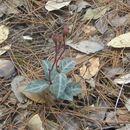Comprehensive Description
provided by North American Flora
Chimaphila guatemalensis Rydberg, sp. nov
Suffruticose perennial; stem terete, 1-2 dm. high; leaves narrowly lanceolate, acuminate, 6-8 cm. long, sharply serrate with slender teeth, dark-green and often jnottled above, brown beneath; peduncles about 15 cm. long; inflorescence subumbellate, 1-3-flowered; sepals semioval, as long as broad, erose; petals orbicular, 8 mm. long; dilated portion of the filaments flabelliform, villous; anthers 4 mm. long, with unusually long tubes; fruit not known.
Type collected at Santiago, Department of Zacatepeques, Guatemala, Rosalio Gomes [J. D. Smith, PI. Guat. no.] 795 (herb. Columbia Univ.). Distribution: Guatemala and Costa Rica.
- bibliographic citation
- John Kunkel Small, NathanieI Lord Britton, Per Axel Rydberg, LeRoy Abrams. 1914. ERICALES, CLETHRACEAE, LENNOACEAE, PTROLACEAE, MONOTROPACEAE, ERICACEAE, UVA-URSI. North American flora. vol 29(1). New York Botanical Garden, New York, NY
Comprehensive Description
provided by North American Flora
Chimaphila acuminata (I^ange) Rydberg, sp. nov
Chimaphila maculata acuminata Lange, Vidensk. Meddel. 1867: 112. 1868.
Suffruticose perennial; stem terete, 1-2 dm. high; leaves in verticils of 3-5, narrowly lanceolate or the lower broader, acuminate, sharply serrate with narrow irregular teeth, directed forward, 2-5 cm. long, dark-green above and mottled along the veins, reddish beneath; peduncles more than 1 dm. long; inflorescence 1-3-flowered; bractlets subulate; sepals roundedovate, obtuse, ciHoIate, as broad as long; petals orbicular, about 8 mm. long; dilated portion of the filaments obovate or obcordate; anthers 3 mm. long, attached at the middle.
Type locality: Alpatlahua, (Vera Cruz. ' Distribution: Southern Mexico.
- bibliographic citation
- John Kunkel Small, NathanieI Lord Britton, Per Axel Rydberg, LeRoy Abrams. 1914. ERICALES, CLETHRACEAE, LENNOACEAE, PTROLACEAE, MONOTROPACEAE, ERICACEAE, UVA-URSI. North American flora. vol 29(1). New York Botanical Garden, New York, NY
Comprehensive Description
provided by North American Flora
Chimaphila maculata (L.) Pursh, Fl. Am. Sept. 300. 1814
Pyrola maculata L. Sp. PI. 396. 1753.
Pyrola or Chimaphila Durandii Raf. Atl. Jour. 119. 1832.
Suffruticose perennial; stem terete, 1 dm. high or less; leaves in verticils of 2-4, shortpetioled; leaves lanceolate, often narrowly so, acute at the apex, sharply serrate with few calloustipped teeth, 1.5-7 cm. long, dark-green above, mottled along the veins with white or light green, reddish-brown beneath, with faint lateral veins; peduncles 1 dm. long or less; inflorescence subumbellate, 1-4-flowered; flowers nodding; bracts linear-setaceous or none; sepals elliptic, ciliolate, obtuse; petals oval, ciliolate, white or rose-colored; dilated part of the filaments obovate, villous especially on the margin, 6 mm. long; anthers 2.5-3 mm. long, attached near the middle; capsule depressed-globose, about 7 mm. broad.
Type locality : Woods of North America.
Distribution: Woods, from Massachusetts to Georgia, Alabama, Ohio, and Ontario.
- bibliographic citation
- John Kunkel Small, NathanieI Lord Britton, Per Axel Rydberg, LeRoy Abrams. 1914. ERICALES, CLETHRACEAE, LENNOACEAE, PTROLACEAE, MONOTROPACEAE, ERICACEAE, UVA-URSI. North American flora. vol 29(1). New York Botanical Garden, New York, NY
Comprehensive Description
provided by North American Flora
Chimaphila dasystemma Torrey (in herb.), sp. nov
Suffruticose perennial; stem terete, rarely more than 1 dm. high; leaves in verticils of 2-4, usually very thick, ovate, 2-6 cm. long, with few, usually rather small teeth, acute, darkgreen above and more or less mottled along the veins; peduncles about 1 dm. long; inflorescence subumbellate, 1-4-flowered; bracts small, lanceolate or subulate; pedicels more or less spreading; sepals rounded-ovate, obtuse, erose; petals white or pink, orbicular, 6-7 mm. long; dilated part of the filaments broadly obovate or orbicular, villous; anthers about 3 mm. long; capsule obovoid, about 8 mm. thick.
Type collected in Mexico [definite locality not given], Thomas Coulter (herb. Columbia Univ.). Distribution: From Sonora to Guatemala.
- bibliographic citation
- John Kunkel Small, NathanieI Lord Britton, Per Axel Rydberg, LeRoy Abrams. 1914. ERICALES, CLETHRACEAE, LENNOACEAE, PTROLACEAE, MONOTROPACEAE, ERICACEAE, UVA-URSI. North American flora. vol 29(1). New York Botanical Garden, New York, NY
Chimaphila maculata
provided by wikipedia EN
Chimaphila maculata (spotted wintergreen, also called striped wintergreen, striped prince's pine, spotted pipsissewa, ratsbane, or rheumatism root) is a small, perennial, evergreen herb native to eastern North America and Central America, from southern Quebec west to Illinois, and south to Florida and Panama.
Description
It has dark green, variegated leaves 2–7 cm (0.8–2.8 in) in length, and 6–26 mm (0.2–1.0 in) in width. The variegation of the leaves arises from the distinct white veins contrasted with the dark green of the leaf.
The stems emerge from creeping rhizomes, growing 10–25 cm (4–10 in) tall. The nearly round flowers, which appear in early summer, are found on top of tall stalks. They are white or pinkish and are insect pollinated. The flowers mature to small (6–8 mm (0.24–0.31 in) in diameter) capsules bearing the seeds of the plant, which are dispersed by the wind.
Flowering on Snowbird Mountain
Ecology
It can be found in sandy habitats, well-drained upland forests, oak-pine woods, and similar mesic habitats. It is very tolerant of acidic soil.
Medicinal history
"The Creek Indians called it 'pipsisikweu' – which means 'breaks into small pieces' – after the supposed ability to break down gallstones and kidney stones. ... Native Americans used its leaf tea to treat rheumatism and stomach problems, and crushed leaves were applied as a poultice to sores and wounds."[1]
Conservation status
Spotted wintergreen is endangered in Canada, as there are four living populations in southern Ontario, and there is one extremely small extant population in Quebec.
It is endangered in Illinois and Maine.[2] In New York it is considered Exploitably Vulnerable.[2]
See also
References

- license
- cc-by-sa-3.0
- copyright
- Wikipedia authors and editors
Chimaphila maculata: Brief Summary
provided by wikipedia EN
Chimaphila maculata (spotted wintergreen, also called striped wintergreen, striped prince's pine, spotted pipsissewa, ratsbane, or rheumatism root) is a small, perennial, evergreen herb native to eastern North America and Central America, from southern Quebec west to Illinois, and south to Florida and Panama.
- license
- cc-by-sa-3.0
- copyright
- Wikipedia authors and editors

